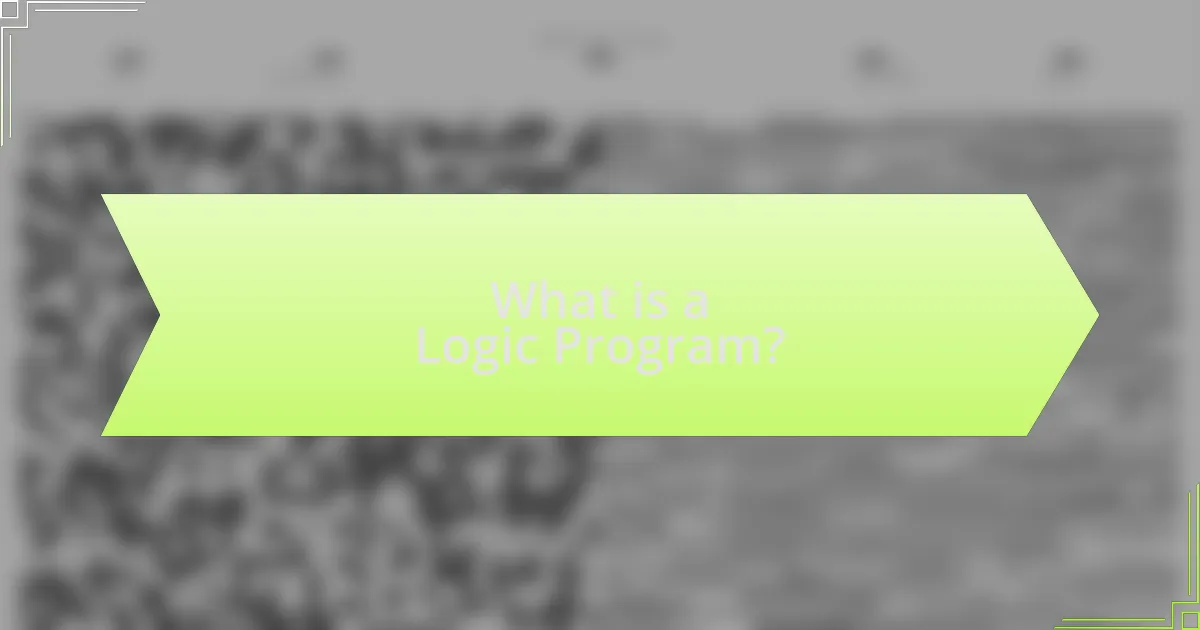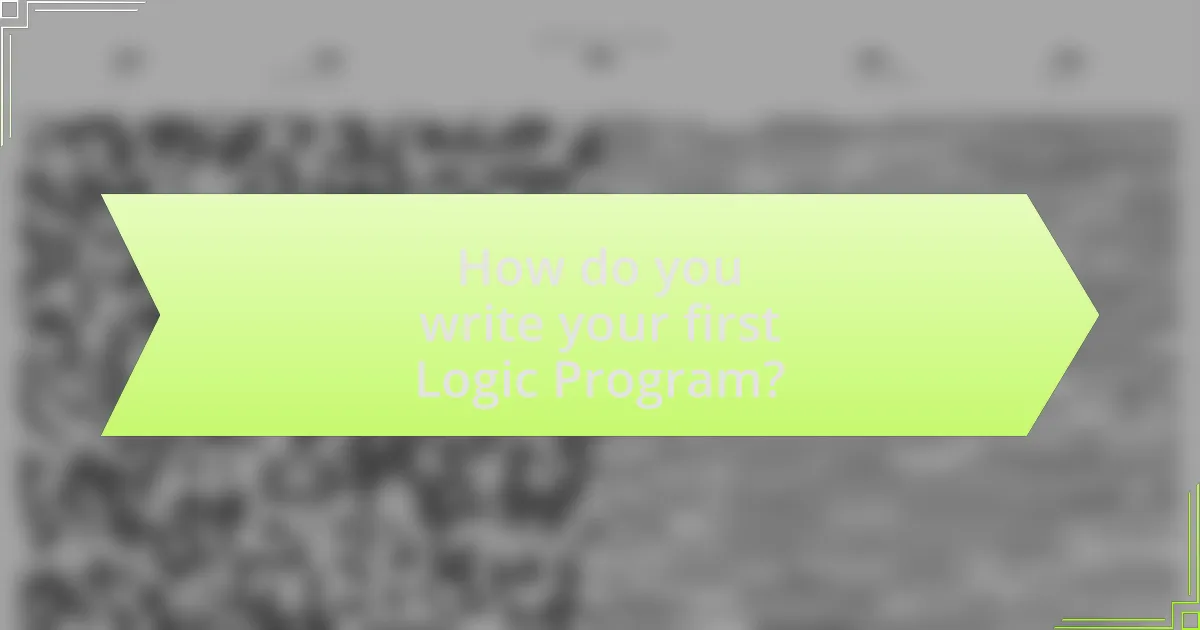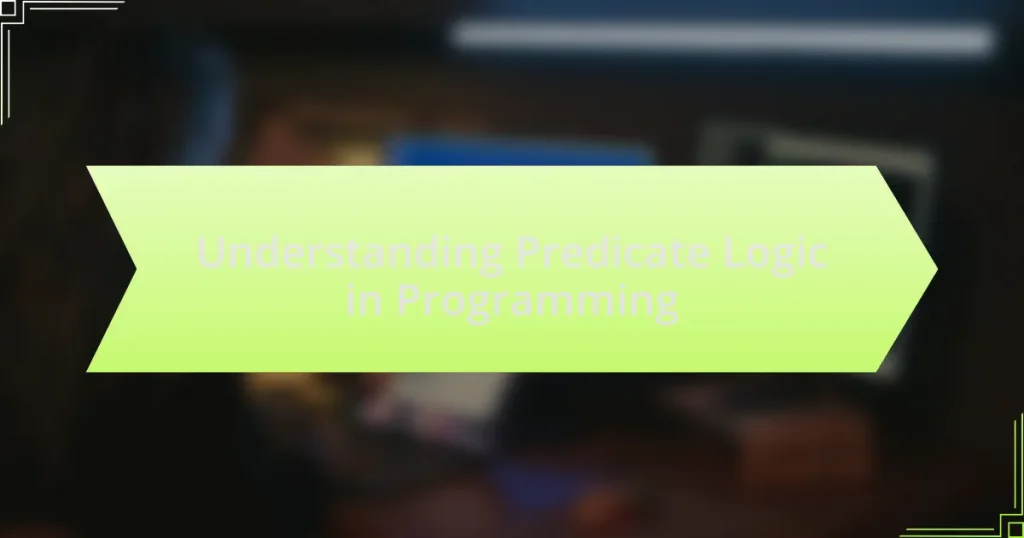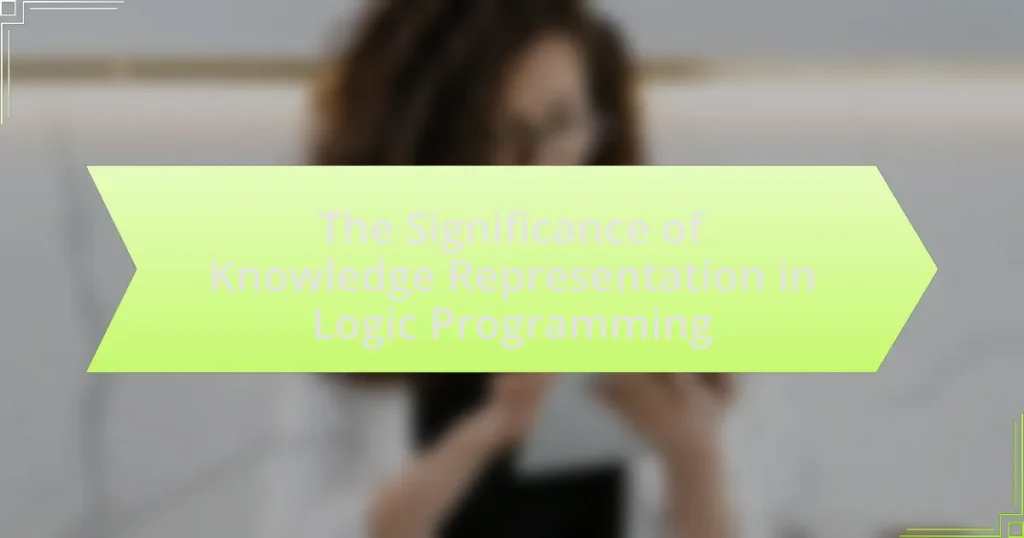A Logic Program is a structured set of rules and facts expressed in a formal language, primarily utilized in artificial intelligence and computational logic to derive conclusions from premises. This article provides a comprehensive overview of Logic Programming, detailing its fundamental components—facts, rules, and queries—and how they interact through inference. It covers key principles, the importance of declarative programming, and the process of unification, along with practical guidance on writing and debugging Logic Programs. Additionally, it highlights recommended tools, languages, and resources for beginners, ensuring a solid foundation for those looking to embark on their journey in Logic Programming.

What is a Logic Program?
A logic program is a set of rules and facts expressed in a formal language that defines a logical relationship among entities. It is primarily used in the field of artificial intelligence and computational logic to derive conclusions from given premises. Logic programs are typically written in languages such as Prolog, where the program consists of a series of clauses that represent facts and rules. The correctness of a logic program can be validated through its ability to produce accurate inferences based on the defined relationships, making it a powerful tool for problem-solving and knowledge representation in various applications.
How does a Logic Program function?
A logic program functions by using a set of rules and facts to derive conclusions through a process called inference. In this paradigm, the program consists of logical statements that define relationships and conditions, allowing the system to answer queries based on the provided information. The inference engine evaluates these rules and facts, applying logical reasoning to deduce new information or verify existing claims. This method is foundational in artificial intelligence and computational logic, as it enables automated reasoning and problem-solving capabilities.
What are the fundamental components of a Logic Program?
The fundamental components of a Logic Program are facts, rules, and queries. Facts represent basic assertions about the world, rules define relationships between facts and allow for inference, and queries are used to retrieve information based on the facts and rules defined in the program. For example, in Prolog, a common logic programming language, a fact might state “cat(tom).” A rule could be “mammal(X) :- cat(X).” This structure enables logical reasoning and problem-solving within the program.
How do these components interact within a Logic Program?
In a Logic Program, components such as facts, rules, and queries interact through a process of logical inference. Facts represent basic assertions about the world, rules define relationships and conditions under which certain conclusions can be drawn, and queries are used to retrieve information based on the established facts and rules.
When a query is posed, the logic engine evaluates it against the existing facts and applies the rules to derive new information or confirm existing knowledge. This interaction is governed by the principles of logical deduction, where the program systematically explores possible conclusions based on the provided data. For instance, if a fact states “Socrates is a man” and a rule states “All men are mortal,” the query “Is Socrates mortal?” will trigger the logic engine to infer the answer based on these components.
This structured interaction allows Logic Programs to solve complex problems by breaking them down into simpler, manageable parts, demonstrating the power of logical reasoning in programming.
What are the key principles of Logic Programming?
The key principles of Logic Programming include the use of facts, rules, and queries to derive conclusions. In Logic Programming, facts represent basic assertions about the world, rules define relationships and logical implications, and queries are used to ask questions about the facts and rules. This paradigm is based on formal logic, particularly predicate logic, allowing for automated reasoning and problem-solving. The validity of these principles is supported by the success of Logic Programming languages, such as Prolog, which have been widely used in artificial intelligence and computational linguistics since their development in the 1970s.
Why is declarative programming important in Logic Programs?
Declarative programming is important in Logic Programs because it allows developers to express the logic of computation without detailing the control flow. This abstraction simplifies the programming process, enabling programmers to focus on what the program should accomplish rather than how to achieve it. In Logic Programming, such as Prolog, rules and facts are defined declaratively, which facilitates reasoning about the problem domain and enhances code readability. The declarative nature also supports automatic reasoning and inference, making it easier to derive conclusions from the given facts and rules, thus improving efficiency in problem-solving.
How does unification work in Logic Programming?
Unification in Logic Programming is a process that determines if two terms can be made identical by finding a suitable substitution for their variables. This process involves matching the structure of the terms and replacing variables with constants or other variables to achieve equality. For example, unifying the terms “X + 1” and “2 + Y” would result in the substitutions X = 2 and Y = 1, making both terms identical. Unification is fundamental in logic programming languages like Prolog, where it enables the resolution of queries against a knowledge base by systematically applying substitutions to derive conclusions.

What tools and languages are used for Logic Programming?
Prolog is the primary language used for logic programming, known for its declarative nature and ability to express complex relationships. Other notable languages include Mercury, which emphasizes efficiency and strong typing, and Datalog, often used in database queries. Tools that support logic programming include SWI-Prolog, a widely used Prolog interpreter, and ECLiPSe, which provides a robust environment for constraint logic programming. These languages and tools are foundational in the field, enabling developers to implement logic-based solutions effectively.
Which programming languages are best suited for beginners in Logic Programming?
Prolog and Mercury are the programming languages best suited for beginners in Logic Programming. Prolog, developed in the 1970s, is widely recognized for its simplicity and declarative nature, allowing users to express logic without needing to specify control flow. Mercury, designed in the 1990s, offers a more modern approach with strong typing and efficiency, making it suitable for beginners who want to learn logic programming concepts while also focusing on performance. Both languages have extensive documentation and community support, facilitating the learning process for newcomers.
What are the features of Prolog that make it popular for Logic Programming?
Prolog is popular for logic programming due to its declarative nature, which allows users to express logic without specifying control flow. This feature enables programmers to focus on what the program should accomplish rather than how to achieve it. Additionally, Prolog’s use of facts and rules facilitates natural representation of relationships and knowledge, making it suitable for applications in artificial intelligence, such as natural language processing and expert systems. The built-in backtracking mechanism allows Prolog to automatically explore different possibilities, enhancing problem-solving capabilities. Furthermore, Prolog’s support for unification and pattern matching simplifies the process of querying and reasoning about data. These features collectively contribute to Prolog’s effectiveness and popularity in the field of logic programming.
How can beginners get started with SWI-Prolog?
Beginners can get started with SWI-Prolog by downloading and installing the software from the official SWI-Prolog website. After installation, they should familiarize themselves with the integrated development environment (IDE) provided, which includes a console for executing Prolog queries and a text editor for writing code. Additionally, beginners can explore the extensive documentation and tutorials available on the SWI-Prolog website, which cover fundamental concepts such as facts, rules, and queries. Engaging with community resources, such as forums and online courses, can also enhance their learning experience. These steps provide a structured approach to understanding and utilizing SWI-Prolog effectively.
What development environments can be used for writing Logic Programs?
Development environments for writing Logic Programs include SWI-Prolog, GNU Prolog, and ECLiPSe. SWI-Prolog is widely used due to its extensive libraries and user-friendly interface, making it suitable for beginners. GNU Prolog offers a native code compiler, which enhances performance and is also open-source. ECLiPSe is designed for constraint logic programming and provides powerful tools for solving complex problems. These environments are recognized for their capabilities in supporting the development and execution of logic programs effectively.
How do IDEs enhance the Logic Programming experience?
IDEs enhance the Logic Programming experience by providing features such as syntax highlighting, debugging tools, and code completion that streamline the development process. These features allow programmers to write and understand code more efficiently, reducing errors and improving productivity. For instance, syntax highlighting helps in visually distinguishing different elements of the code, making it easier to read and comprehend. Debugging tools enable users to identify and fix issues in real-time, while code completion assists in writing code faster by suggesting possible continuations. Collectively, these enhancements lead to a more intuitive and effective programming environment, facilitating a smoother learning curve for beginners in Logic Programming.
What are some recommended IDEs for beginners?
Some recommended IDEs for beginners include Visual Studio Code, PyCharm, and Eclipse. Visual Studio Code is widely favored for its user-friendly interface and extensive extensions, making it suitable for various programming languages. PyCharm is specifically designed for Python development, offering features like code completion and debugging tools that enhance the learning experience. Eclipse is a versatile IDE that supports multiple languages and is particularly popular for Java development, providing a robust environment for beginners to learn programming concepts. These IDEs are recognized for their accessibility and supportive features, making them ideal choices for those new to coding.

How do you write your first Logic Program?
To write your first Logic Program, start by defining the problem you want to solve using logical rules and facts. For example, if you want to create a program that determines family relationships, you would define facts such as “parent(john, mary)” and rules like “sibling(X, Y) :- parent(Z, X), parent(Z, Y).” This structure allows the program to infer relationships based on the defined rules and facts. Logic programming languages like Prolog are commonly used for this purpose, as they provide built-in mechanisms for handling logical queries and reasoning.
What are the steps to create a simple Logic Program?
To create a simple Logic Program, follow these steps: first, define the problem you want to solve using logical rules. Next, choose a logic programming language, such as Prolog, which is widely used for this purpose. Then, write the facts and rules that represent the relationships and conditions of your problem. After that, implement a query to test your program and retrieve results based on the defined facts and rules. Finally, debug and refine your program to ensure it works as intended. These steps are essential for developing a functional Logic Program, as they provide a structured approach to problem-solving using logic.
How do you define facts and rules in a Logic Program?
In a Logic Program, facts are defined as basic assertions about the world that are unconditionally true, while rules are conditional statements that describe relationships between facts and infer new information. For example, a fact could be “Birds fly,” indicating a general truth, whereas a rule might state, “If X is a bird, then X can fly,” which allows for the derivation of new facts based on existing ones. This structure enables logical reasoning and inference, forming the foundation of logic programming languages like Prolog.
What is the process for querying a Logic Program?
The process for querying a Logic Program involves formulating a query in the form of a goal or a question that the program can evaluate. This typically includes specifying the predicates and their arguments that represent the information you want to retrieve or the conditions you want to check. The Logic Program then uses its rules and facts to determine if the query can be satisfied, often employing a resolution strategy or backtracking to find valid solutions. This process is foundational in logic programming, as it allows users to extract meaningful information from the defined knowledge base.
What common mistakes should beginners avoid when writing Logic Programs?
Beginners should avoid several common mistakes when writing Logic Programs, including neglecting to understand the underlying logic principles, failing to properly structure their code, and not testing their programs thoroughly. Understanding logic principles is crucial because it forms the foundation for effective problem-solving in Logic Programming. Proper structuring, such as using clear predicates and avoiding overly complex rules, enhances readability and maintainability. Additionally, thorough testing is essential to identify and fix errors, as untested programs can lead to unexpected behavior. These practices are supported by programming education resources that emphasize the importance of foundational knowledge, code organization, and rigorous testing in software development.
How can improper syntax affect your Logic Program?
Improper syntax can lead to errors and unexpected behavior in your Logic Program. When the syntax is incorrect, the program may fail to compile or run, resulting in runtime errors that prevent the intended logic from executing. For example, a missing parenthesis or incorrect operator can cause the program to misinterpret the logic, leading to incorrect outputs or infinite loops. This is supported by programming language documentation, which often emphasizes that syntax errors are a common source of bugs, highlighting the importance of adhering to the specific syntax rules of the language being used.
What are the pitfalls of misunderstanding logical operators?
Misunderstanding logical operators can lead to incorrect program logic and unintended outcomes. For instance, confusing the AND operator with the OR operator can result in conditions that do not trigger as expected, causing a program to fail or behave unpredictably. Additionally, misinterpreting operator precedence can lead to errors in complex expressions, where the order of evaluation affects the final result. This is evidenced by programming languages like Python, where the expression “True or False and False” evaluates to True due to operator precedence, which may not align with a beginner’s intuitive understanding. Such pitfalls can hinder the development of effective logic programs and lead to debugging challenges.
What are some best practices for writing effective Logic Programs?
To write effective Logic Programs, prioritize clarity, modularity, and efficiency. Clarity ensures that the logic is easily understandable, which is essential for debugging and maintenance. Modularity allows for the separation of concerns, enabling easier testing and reuse of code. Efficiency is crucial for performance, particularly in complex queries or large datasets.
For instance, using clear variable names and comments can significantly enhance the readability of the code, while breaking down complex rules into smaller, manageable predicates can improve modularity. Additionally, employing built-in predicates and avoiding unnecessary computations can optimize performance. These practices are supported by programming principles that emphasize maintainability and performance in software development.
How can you structure your Logic Program for better readability?
To structure your Logic Program for better readability, use clear and consistent naming conventions for predicates and variables. This practice enhances understanding by making the purpose of each component immediately apparent. Additionally, organize your code into logical sections with comments that explain the functionality of each part, which aids in navigation and comprehension. Indentation and spacing should be applied consistently to visually separate different logical blocks, making the program easier to scan. Following these guidelines improves readability, as evidenced by studies showing that well-structured code reduces cognitive load and increases maintainability.
What debugging techniques are useful for Logic Programs?
Useful debugging techniques for logic programs include tracing, which allows developers to follow the execution of the program step-by-step, and using a debugger tool that provides breakpoints and variable inspection. Tracing helps identify where the logic diverges from expected outcomes, while debugger tools facilitate the examination of program state at specific points. Additionally, employing unit tests can validate individual components of the logic program, ensuring that each part functions correctly in isolation. These techniques are effective because they provide clear insights into the program’s behavior and help isolate errors systematically.
What resources are available for further learning in Logic Programming?
Comprehensive resources for further learning in Logic Programming include textbooks, online courses, and academic papers. Notable textbooks such as “Programming in Prolog” by Clocksin and Mellish provide foundational knowledge and practical examples. Online platforms like Coursera and edX offer courses on Logic Programming, often featuring interactive exercises and peer discussions. Additionally, academic papers, such as “The Art of Prolog” by Sterling and Shapiro, present advanced concepts and applications in the field. These resources collectively support learners in deepening their understanding of Logic Programming principles and practices.
Which online courses are recommended for beginners?
Recommended online courses for beginners in writing logic programs include “Introduction to Logic Programming” on Coursera, which covers foundational concepts and practical applications. Additionally, “Learn Prolog Now!” is a free resource that provides interactive lessons on Prolog, a popular logic programming language. These courses are designed to equip beginners with essential skills and knowledge in logic programming, making them suitable starting points for those new to the field.
What books provide a solid foundation in Logic Programming?
“Programming in Prolog” by Clocksin and Mellish provides a solid foundation in Logic Programming. This book is widely recognized for its clear explanations and practical examples, making it suitable for beginners. Additionally, “The Art of Prolog” by Sterling and Shapiro offers in-depth insights into Prolog programming and its applications, further solidifying its status as a foundational text. Both books are frequently recommended in academic courses and are used as standard references in the field, demonstrating their credibility and effectiveness in teaching Logic Programming concepts.
How can you troubleshoot common issues in your first Logic Program?
To troubleshoot common issues in your first Logic Program, systematically check for syntax errors, logical inconsistencies, and runtime errors. Syntax errors can be identified by reviewing the code for proper formatting and structure, as most programming environments highlight these issues. Logical inconsistencies require testing the program with various inputs to ensure it produces the expected outputs; if it does not, reevaluate the logic used in the program. Runtime errors can be diagnosed by using debugging tools available in the programming environment, which help trace the execution flow and identify where the program fails. These methods are effective because they address the most frequent problems encountered by beginners, ensuring a smoother programming experience.



